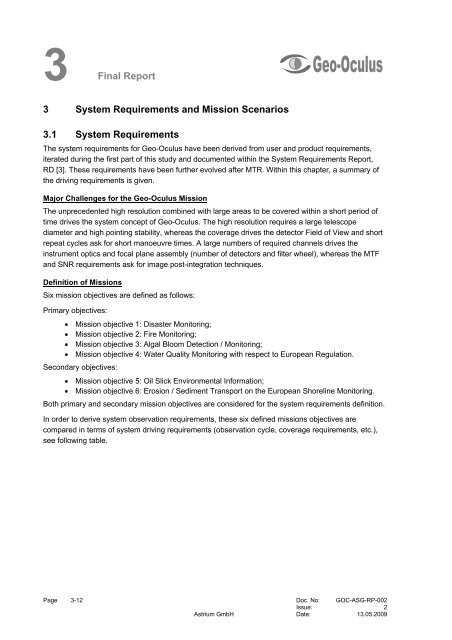4 Final Report - Emits - ESA
4 Final Report - Emits - ESA
4 Final Report - Emits - ESA
Create successful ePaper yourself
Turn your PDF publications into a flip-book with our unique Google optimized e-Paper software.
3 <strong>Final</strong><br />
<strong>Report</strong><br />
3 System Requirements and Mission Scenarios<br />
3.1 System Requirements<br />
The system requirements for Geo-Oculus have been derived from user and product requirements,<br />
iterated during the first part of this study and documented within the System Requirements <strong>Report</strong>,<br />
RD [3]. These requirements have been further evolved after MTR. Within this chapter, a summary of<br />
the driving requirements is given.<br />
Major Challenges for the Geo-Oculus Mission<br />
The unprecedented high resolution combined with large areas to be covered within a short period of<br />
time drives the system concept of Geo-Oculus. The high resolution requires a large telescope<br />
diameter and high pointing stability, whereas the coverage drives the detector Field of View and short<br />
repeat cycles ask for short manoeuvre times. A large numbers of required channels drives the<br />
instrument optics and focal plane assembly (number of detectors and filter wheel), whereas the MTF<br />
and SNR requirements ask for image post-integration techniques.<br />
Definition of Missions<br />
Six mission objectives are defined as follows:<br />
Primary objectives:<br />
• Mission objective 1: Disaster Monitoring;<br />
• Mission objective 2: Fire Monitoring;<br />
• Mission objective 3: Algal Bloom Detection / Monitoring;<br />
• Mission objective 4: Water Quality Monitoring with respect to European Regulation.<br />
Secondary objectives:<br />
• Mission objective 5: Oil Slick Environmental Information;<br />
• Mission objective 6: Erosion / Sediment Transport on the European Shoreline Monitoring.<br />
Both primary and secondary mission objectives are considered for the system requirements definition.<br />
In order to derive system observation requirements, these six defined missions objectives are<br />
compared in terms of system driving requirements (observation cycle, coverage requirements, etc.),<br />
see following table.<br />
Page 3-12 Doc. No: GOC-ASG-RP-002<br />
Issue: 2<br />
Astrium GmbH Date: 13.05.2009

















